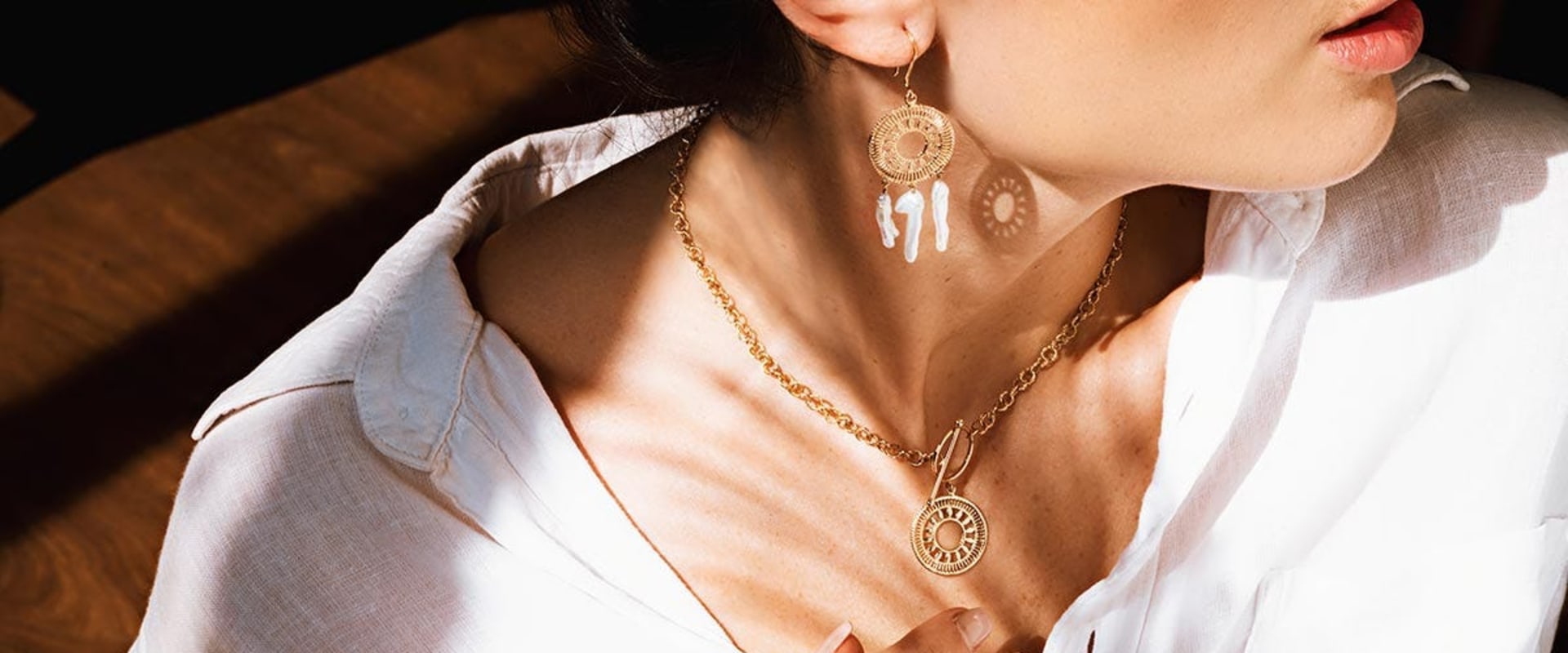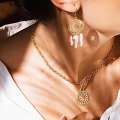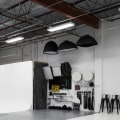DSLR camera for jewelry photography Digital reflex cameras are more expensive than other types of cameras, but they offer features and image quality that are unmatched by any other type of camera. If you really want to take high-quality photos of your jewelry, then a digital SLR camera is the way to go. Once you've decided to become a professional, especially in a field like jewelry photography, where technical skill is essential, it makes sense to opt for industry standard equipment. There is no better example of this than the Canon EOS R6, which is a brilliant and powerful camera that is as reliable as it seems and the preferred choice of professionals around the world.
By taking 20.1 MP photos and being compatible with practically all the editing programs and recording accessories that exist, the R6 won't leave you feeling up to it. The RAW files generated by this camera are easy to edit, but even if you don't want to waste time in post-production, Canon's have class-leading colors and rarely require much manipulation to begin with. The Canon EOS R6 is a rugged camera, but that's because it's a rugged, weather-sealed beast that's been designed for the rigors of field use. The large body makes it comfortable to hold during long jewelry photography sessions, and you have a range of fully customizable buttons and dials to speed up your workflow.
The clean HDMI output via micro HDMI allows you to monitor your stream on an external screen while recording. The 10 Gbps USB-C port allows for fast data transfer and easy connection to applications such as Lightroom and Capture One. The two UHS-II card slots meet storage needs and has two 3.5 mm audio jacks for recording and monitoring audio. The Canon LP-E6N batteries used here have enough power for about 400 shots with the EVF.
You can expand it to more than 500 with just the LCD screen, but in a studio environment, where the camera is likely to be connected, battery life will never be an issue. If you're looking for a professional camera in Nikon's stables, especially for jewelry photography, I would choose the Nikon Z6 II. Its video features aren't as robust as those of the competition, but in the case of still photography, this will hold true with the best in this price range. When shooting 24.5 MP photos and with exceptional ISO performance, the Z6 II is the perfect camera for jewelry.
The camera's RAW files are also very good, and the slightly warmer tone of the JPEG files integrated in the camera is ideal for showing the golden glow of the jewelry you're photographing. Video features include 4K at 24 full frames and 4K/60 with APS-C cutout. The fast Wi-Fi (802.11ac) and Bluetooth connection, not to mention the mini HDMI and the 5 Gbps USB-C, ensure a fast connection to a PC or phone. It has two storage card slots, but one is a CFexpress slot and the other a UHS-II slot.
With 410 shots with the LCD screen (340 with the EVF), the battery life is a little below average, but I repeat, this is not a problem in studio sessions with a network connection. The 24.2 MP BSI CMOS sensor is still an exceptional sensor, especially in low light. Nearly 700 PDAF sensors cover 93% of the sensor and an additional 425 CDAF points are obtained to facilitate autofocus. A fast sync speed and excellent 4K video quality round out the features.
The connectivity is good, as Sony offers a 5 Gbps USB-C port, two 3.5 mm audio connectors and a micro HDMI output for recording. The camera can be connected to a PC and has Wi-Fi and NFC support for fast wireless pairing with a smartphone. The 30.3 MP sensor has a higher resolution than what you'll find in most mirrorless cameras in this price range. The additional resolution and sharpness of Canon EF and RF lenses should allow you to crop photos for better framing or magnification; perfect for taking pictures of jewelry.
If you're looking for a video, there are better options. Wi-Fi 802.11n and BT LE 4.1 ensure excellent wireless connectivity with a smartphone, and the 5 Gbps USB-C port and HDMI output allow for an easy connection. Dual 3.5 mm audio jacks meet monitoring needs. The battery life of Canon's EOS R line of cameras is below average, but with 370 shots, it's manageable.
However, if you are going to photograph jewelry in a studio, battery life is no longer a cause for concern, since you can use fake batteries and even USB-C batteries. You can think of the Sony A7c as a smaller a7 III with much higher AF. Sony claims this is the smallest and lightest full-frame mirrorless camera out there and, at just 1.12 pounds, you can see why. However, it is no less capable for its size and represents a significant improvement over the A7iii, it is successful!.
This camera's 24 MP CMOS sensor is gorgeous, and with full-frame PDAF coverage combined with Sony's incredible AF tracking system, you'll get one of the most capable mirrorless camera systems on the market. Video capabilities are limited to 4K 24 or 4K at 30 FPS (1.2 times crop) with 8-bit color depth, but that's still enough to capture a good jewel video in the blink of an eye. The camera supports connection via USB-C and monitoring via micro HDMI. Two 3.5 mm audio jacks are responsible for audio monitoring, and 802.11ac Wi-Fi ensures fast transfers to a smartphone.
The 24.2 MP sensor here also records incredible still images and videos, if you put a little effort into focusing. Speaking of AF, Panasonic uses a contrast-based depth from blur (DFD) system that is slower than a PDAF system, but more reliable. What sets it apart from the rest is a 96 MP high-resolution mode that can be used to capture ridiculously sharp pictures of jewelry. It has the usual range of HDMI, USB-C ports and two 3.5 mm audio ports, but as an added benefit, the S5 can also send phantom power to XLR microphones.
The battery life is decent, with 460 shots, and for studio sessions, the camera can also consume power directly from the USB-C port, allowing you to change batteries on the go. It's for very good reason that many consider the Fuji X-T4 to be the queen of APS-C mirrorless cameras. That sensor may be smaller than the full-frame sensor, but the X-T4 has one of the sharpest, highest-resolution sensors you can find for that price. To top it all off, each and every one of Fuji's lenses are incredibly sharp and well-built.
The X-T4's 26MP X-Trans CMOS sensor doesn't look like most mirrorless camera sensors. It has an unusual X-Trans filter matrix (hence the name) that eliminates the need for an AA filter, allowing more light to enter and better sharpness. AF is good, but it's not reliable with small objects, such as jewelry, so you'll need to take precautions when focusing. The X-T4 is the largest mirrorless body in Fuji's X-series, and that's because it has a more video-focused design with a deeper grip for better handling on the move.
With buttons and dials for almost every function, ergonomics and ease of use are unparalleled, and the screen is fully articulated. Wi-Fi and Bluetooth connectivity are good, but not as fast as the competition. However, it supports 5Gbps USB-C and supports two UHS-II class SD cards for redundant storage. It has a 3.5 mm microphone input for audio, but you'll need the included 3.5 mm USB-C adapter for monitoring.
The X-T4 uses a larger battery than previous Fuji cameras, and the battery life is pretty good with 500 shots. The camera can be charged via USB-C and also supports a battery grip that can triple battery life. The camera takes 24.1 MP photos with an APS-C CMOS sensor. A dedicated PDAF sensor close to the prism helps achieve the fast and highly responsive autofocus that characterizes digital reflex cameras, although the sensor itself uses a CDAF system.
For this reason, I wouldn't recommend shooting with LiveView turned on unless, of course, you're shooting with manual focus. It has Wi-Fi and NFC, but it's not very fast and only good enough to transfer photos in a hurry. USB speeds are also limited to 480 Mbps and data is stored in a single SDXC card slot. There is a mini-HDMI output, but of limited use for recording.
The LP-E10's battery is quite small, so you only get 500 photos of its lifespan, compared to the more than 1000 you'd get in a larger DSLR. That said, you'll get much longer battery life if you avoid using LiveView. Would you buy a piece of jewelry that doesn't show details? Probably not. That's why you should focus on choosing the best camera for jewelry photography.
A camera with many functions can manipulate lighting, eliminate reflections and do much more. The reason this unit is a great choice for taking pictures of jewelry is mainly its minimum focusing distance, which is only 11 inches. This means that you can get fantastic close-ups and capture everything you want to highlight with incredible detail and quality. The advanced 24.2 megapixel full-frame sensor is another important factor in producing premium images, and probably one of the most important and best features of this unit is its 693-point phase detection.
The 425-point contrast detection autofocus is also something you shouldn't overlook, since it covers 93 percent of the frame and tracks and focuses on very fast targets, which is impressive. You can also use this camera to record videos with 4K resolution in slow motion up to 120 FPS, which can also be used for jewelry presentations. It's a great option for shooting commercials and other types of promotional material. The touchscreen is tilted, which means that the shooting process will also be much more comfortable.
With its 45.7 megapixel sensor and a native ISO sensitivity range of 64 to 25 600, Nikon managed to do an incredible job of meeting diverse photographic needs in one package. The 30-megapixel full-frame sensor is also an improvement and is more than adequate for taking pictures of jewelry and other shiny objects, even in low-light rooms. One of the most important improvements provided by the EOS 5D Mark IV is the Dual Pixel Raw, which is a new image capture mode that can take two images at the same time. At the center of this unit, you'll find a 16 megapixel sensor and an updated Venus Engine image processor that are more than suitable for jewelry photography.
In addition to five-axis image stabilization and the foldable screen, you also have a screen with touch control, programmable function buttons, intelligent automatic mode and much more. The Fujifilm X-T3 is a highly versatile camera that can be adapted to a wide variety of needs, including product or jewelry photography. It has multiple new features and improvements, which focus mainly on components and specifications, and you'll also find some minor updates to the camera body. The biggest reform took place in the image processing department, with its brand-new 26 megapixel BSI X-Trans APS-C sensor and a quad-core image processor that brought a breath of fresh air and life to this incredible unit.
The improved sensitivity of the AF in low light conditions is another big improvement, and it's one of the main reasons why the X-T3 works so well at capturing images of jewelry. Depending on your budget, you'll need to find the right balance between camera and lens. There are some very good entry-level DSLRs with an APS-C sensor (Canon EOS 800D). For full-frame sensors, the basic model is the Canon EOS 6D Mark II, followed by the 5D Mark IV.
If you need a hybrid video camera to photograph jewelry or see no reason to spend too much on a mirrorless case, the Sony Alpha 7 III is the perfect jewelry camera for you. However, the challenge lies in not spending too much on the body and choosing a jewelry camera with the right lens ecosystem. The Nikon COOLPIX P900 can be considered the best camera for jewelry photography if you are looking for a model equipped with a PSAM mode dial. This jewelry camera also allows you to record clips in 4K resolution in slow motion up to 120 fps.
As a jewelry photographer or seller trying to publish photos of jewelry products on e-commerce platforms, you need a camera with an excellent selection of lenses and impeccable image quality. Many photographers consider Nikon cameras to be the best photography devices for photographing jewelry because they produce images of impressive quality. The best camera for jewelry photography would be something like a Hasselblad or Fuji GFX medium format system. Jewelry photography is the most complicated and challenging, but with a quality camera you can solve these difficulties.
Jewelry photography requires a great degree of technical skill, so make sure you master your craft and your camera before starting a session. For this reason, choosing the right camera for jewelry photography can be a daunting task, considering the budget, purpose, quality, lens compatibility, etc. The Sony a7 III is a well-built and highly functional jewelry camera with a 24 MP and 35 mm image sensor that can capture 10 images per second. Choosing the best cameras for jewelry photography can be quite a challenge, since you need a large unit that captures every detail to provide an adequate presentation of the piece.
Place a sheet of paper around and on the bottom of the camera lens to eliminate reflection from the jewelry photograph. .




Leave Message